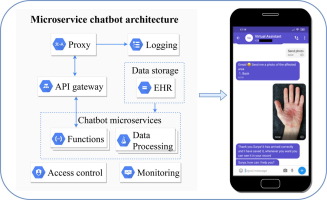当前位置:
X-MOL 学术
›
J. Biomed. Inform.
›
论文详情
Our official English website, www.x-mol.net, welcomes your
feedback! (Note: you will need to create a separate account there.)
Microservice chatbot architecture for chronic patient support.
Journal of Biomedical informatics ( IF 4.0 ) Pub Date : 2019-10-14 , DOI: 10.1016/j.jbi.2019.103305 Surya Roca 1 , Jorge Sancho 1 , José García 1 , Álvaro Alesanco 1
Journal of Biomedical informatics ( IF 4.0 ) Pub Date : 2019-10-14 , DOI: 10.1016/j.jbi.2019.103305 Surya Roca 1 , Jorge Sancho 1 , José García 1 , Álvaro Alesanco 1
Affiliation

|
Chatbots are able to provide support to patients suffering from very different conditions. Patients with chronic diseases or comorbidities could benefit the most from chatbots which can keep track of their condition, provide specific information, encourage adherence to medication, etc. To perform these functions, chatbots need a suitable underlying software architecture. In this paper, we introduce a chatbot architecture for chronic patient support grounded on three pillars: scalability by means of microservices, standard data sharing models through HL7 FHIR and standard conversation modeling using AIML. We also propose an innovative automation mechanism to convert FHIR resources into AIML files, thus facilitating the interaction and data gathering of medical and personal information that ends up in patient health records. To align the way people interact with each other using messaging platforms with the chatbot architecture, we propose these very same channels for the chatbot-patient interaction, paying special attention to security and privacy issues. Finally, we present a monitored-data study performed in different chronic diseases, and we present a prototype implementation tailored for one specific chronic disease, psoriasis, showing how this new architecture allows the change, the addition or the improvement of different parts of the chatbot in a dynamic and flexible way, providing a substantial improvement in the development of chatbots used as virtual assistants for chronic patients.
中文翻译:

用于长期患者支持的微服务聊天机器人架构。
聊天机器人能够为患有非常不同状况的患者提供支持。患有慢性疾病或合并症的患者可以从聊天机器人中受益最多,而聊天机器人可以跟踪病情,提供特定信息,鼓励坚持用药等。要执行这些功能,聊天机器人需要合适的基础软件体系结构。在本文中,我们介绍了一个用于长期患者支持的聊天机器人体系结构,该体系结构基于以下三个支柱:通过微服务实现的可伸缩性,通过HL7 FHIR进行的标准数据共享模型以及使用AIML进行的标准对话模型。我们还提出了一种创新的自动化机制,可以将FHIR资源转换为AIML文件,从而促进最终形成患者健康记录的医疗和个人信息的交互和数据收集。为了使人们使用具有聊天机器人体系结构的消息传递平台彼此交互的方式保持一致,我们为聊天机器人与患者之间的交互提供了非常相同的渠道,并特别注意安全性和隐私问题。最后,我们提出了一项针对不同慢性病的监测数据研究,并提出了针对一种特定的慢性病(牛皮癣)量身定制的原型实现,展示了这种新架构如何实现聊天机器人不同部分的更改,添加或改进。以动态,灵活的方式,大大改善了用作慢性患者虚拟助手的聊天机器人的开发。特别注意安全和隐私问题。最后,我们提出了一项针对不同慢性病的监测数据研究,并提出了针对一种特定的慢性病(牛皮癣)量身定制的原型实现,展示了这种新架构如何实现聊天机器人不同部分的更改,添加或改进。以动态,灵活的方式,大大改善了用作慢性患者虚拟助手的聊天机器人的开发。特别注意安全和隐私问题。最后,我们提出了一项针对不同慢性病的监测数据研究,并提出了针对一种特定的慢性病(牛皮癣)量身定制的原型实现,展示了这种新架构如何实现聊天机器人不同部分的更改,添加或改进。以动态,灵活的方式,大大改善了用作慢性患者虚拟助手的聊天机器人的开发。
更新日期:2019-11-04
中文翻译:

用于长期患者支持的微服务聊天机器人架构。
聊天机器人能够为患有非常不同状况的患者提供支持。患有慢性疾病或合并症的患者可以从聊天机器人中受益最多,而聊天机器人可以跟踪病情,提供特定信息,鼓励坚持用药等。要执行这些功能,聊天机器人需要合适的基础软件体系结构。在本文中,我们介绍了一个用于长期患者支持的聊天机器人体系结构,该体系结构基于以下三个支柱:通过微服务实现的可伸缩性,通过HL7 FHIR进行的标准数据共享模型以及使用AIML进行的标准对话模型。我们还提出了一种创新的自动化机制,可以将FHIR资源转换为AIML文件,从而促进最终形成患者健康记录的医疗和个人信息的交互和数据收集。为了使人们使用具有聊天机器人体系结构的消息传递平台彼此交互的方式保持一致,我们为聊天机器人与患者之间的交互提供了非常相同的渠道,并特别注意安全性和隐私问题。最后,我们提出了一项针对不同慢性病的监测数据研究,并提出了针对一种特定的慢性病(牛皮癣)量身定制的原型实现,展示了这种新架构如何实现聊天机器人不同部分的更改,添加或改进。以动态,灵活的方式,大大改善了用作慢性患者虚拟助手的聊天机器人的开发。特别注意安全和隐私问题。最后,我们提出了一项针对不同慢性病的监测数据研究,并提出了针对一种特定的慢性病(牛皮癣)量身定制的原型实现,展示了这种新架构如何实现聊天机器人不同部分的更改,添加或改进。以动态,灵活的方式,大大改善了用作慢性患者虚拟助手的聊天机器人的开发。特别注意安全和隐私问题。最后,我们提出了一项针对不同慢性病的监测数据研究,并提出了针对一种特定的慢性病(牛皮癣)量身定制的原型实现,展示了这种新架构如何实现聊天机器人不同部分的更改,添加或改进。以动态,灵活的方式,大大改善了用作慢性患者虚拟助手的聊天机器人的开发。











































 京公网安备 11010802027423号
京公网安备 11010802027423号